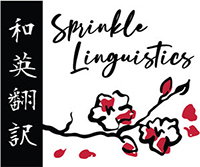Every now and again, I tell my friends or new business connections that I’m a translator and their eyes glaze over in confusion when I explain the services I provide. As any linguist knows, every field has its own unique vocabulary and as an outsider it’s difficult to understand exactly what these terms mean. Many companies and individuals who want translation, interpretation, or localization services do not know much about the industry and often request a different service from what they want. So this time, I want to talk about some commonly used terms in the translation industry and address some questions, I’ve been asked about this business.
- What is the difference between translation and interpretation?
Translation refers to written texts and requires analytical skills, although it does include subtitling multimedia files or translation of a written transcription of a media file. The main service that I offer is translation including both documents and multimedia files. In addition to translation, there is also localization, which is a term used for the translation of websites, advertisements, and entertainment. Localization allows for a larger degree of artistic licence and creativity in order to localize a movie title, advertising slogans, jokes etc so that it is understandable in the language and culture it is translated into.
Interpretation refers to verbal communication and requires a quick response. Consecutive interpretation is done after someone has finished speaking and is often used for meetings. Simultaneous interpreting is done while the speaker is speaking and is often used for multi-national conferences like the World Summit or for court interpreting.
Translators do not always do interpretation and there are interpreters who don’t translate. It’s the difference between a Public Speaker and a Writer, some Writers love speaking publicly and others are shy. Some Public Speakers struggle to write with the same eloquence that they can speak.
- What’s the difference between proofreading and editing?
Proofreading is a bottom-up activity, correcting and checking for the smaller linguistic units of a text such as spelling, word-usage, and grammar. Editing is a top-down activity and checks the content of the text for consistency, phrasing, and conciseness. Both Proofreading and editing are activities that focus on the Target Text (ie. translated text), although bilingual Proofreaders/Editors will also check the Target Text against to Source Text (original document). However, this particular QA (i.e. quality assurance) activity has its own term: checking. In translation, Checking means checking both the translation and source to ensure the translation is accurate, complete, and natural.
However, there is an addition Quality Assurance activity in which comprehending either the Source Text or Target Text is irrelevant and focuses on DTP (Desk Top Publishing). This is called Document Review which ensures the layout of the translation matches the source, and checks for images, text overlap, completed translation, and that the numbers match. One does not need to know either language to perform document review. Some translators also perform Desk Top Publishing services which is fixing the issues found by the Document Reviewer, which could be themselves. DTP can be done on common software like Microsoft Word or digital design software like InDesign or Photoshop.
This is, of course, only a small portion of terms and services within the language industry. What questions do you have about the translation industry and what terms used by translation/localization companies or individuals within the industry confuse you?
